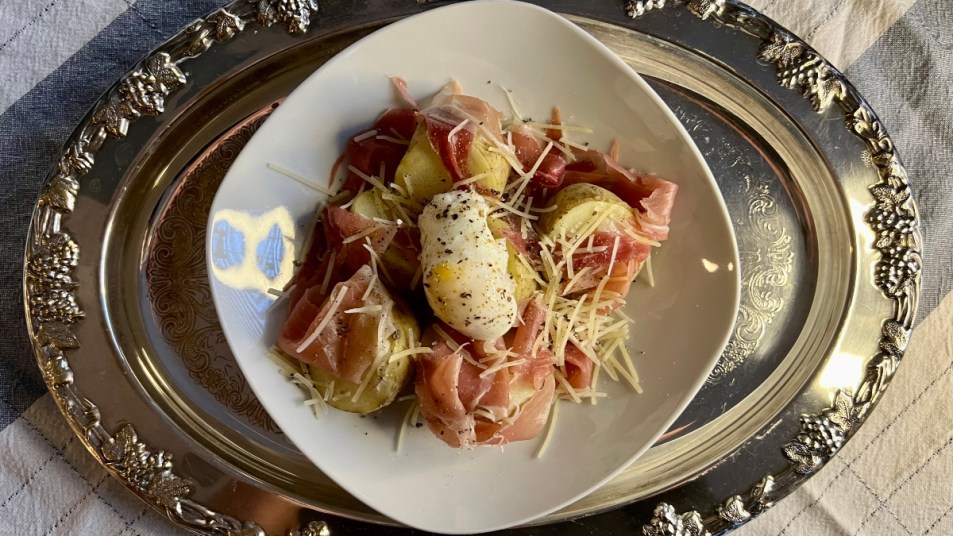Potato Carbonara: Is This International Food Craze Worth the Hype?
An unconventional recipe.

I’ve been in this position more times than I can count: It’s late, I’m hungry, and all I want is something warm and comforting to eat — but I don’t have the energy to turn on the oven. This is where the trendy Japanese recipe for potato carbonara, a microwave-only snack inspired by classic Italian carbonara, comes to the rescue. It’s easy, cheesy, and quick — but is it any good? I decided to find out for myself.
What is carbonara?
Food is like jazz: Understanding the foundations enables you to riff on them and create something new. And so it is with pasta carbonara, a traditionally creamy — but creamless — pasta dish made by tossing hot spaghetti with raw eggs, guanciale, ground black pepper, and pecorino romano cheese. (Learn more about how to make a perfect carbonara from Nadia Munno, “The Pasta Queen.”)
Variations on this ingredient combination abound, but not without controversy: In 2016, a French website’s recipe for a simplified, one-pot iteration with bowtie pasta and créme fraîche sparked an international debate dubbed “Carbonaragate.” Traditionally, Italian carbonara is made with long pasta noodles like spaghetti, and doesn’t contain any dairy. What’s more, the fact that this French version called for boiling the raw guanciale alongside other ingredients, instead of crisping it up in a separate pan, incensed and confounded carbonara purists. I tell you all of this as a kind of disclaimer: In no way is this microwave potato dish authentically Italian — rather, it’s a simple simple snack inspired by beloved flavors.
Where did carbonara come from?
La Cucina Italiana says that carbonara’s roots are likely Roman. She points to the fact that the term “carbonara” is derived from the Italian word carbonaro, which means “coal burner.” This is why some food historians believe carbonara began as a hearty dish prepared for hardworking manual laborers. Italy Magazine says another potential origin story is that American soldiers serving in Rome during World War II coupled bacon and eggs, a popular American breakfast, with pasta, which was widely available — thus creating the template for the future dish. Whatever its roots, carbonara is beloved today.
What are the benefits of using potatoes instead of pasta?
The Japanese snack variation replaces carbonara’s pasta with potatoes. Pasta and potatoes are two of the most wonderful foods in the world — I think we all agree on this, right? — so the idea of swapping one for the other makes sense in certain contexts. To start, potatoes are delicious, versatile, and budget-friendly. Better still, they have several health and nutrition benefits, most notably the fact that they’re packed with fiber, vitamins, and antioxidants, which help prevent diseases like cancer. In fact, studies show that potatoes contribute to gut health and contain anti-diabetic, anti-inflammatory, and cholesterol-lowering properties. When it comes to nutritional benefits, spuds are your buds.
How To Make Potato Carbonara
Japan Today explains that this recipe comes from Japanese supermarket Maruetsu. Maruetsu often shares simple recipes on its Twitter page, and Japan Today notes that this recipe for potato carbonara was particularly popular — the grocery store’s tweet alone garnered over 23,000 likes. “The hot, flaky potatoes, the saltiness of the cheese and ham, and the mild flavor of the egg all come together to create a delicious, blissful dish,” as Japan Today describes it. “The chunkier take on pasta carbonara yet fancier take on cheesy potatoes has taken off on Twitter, with many swearing by its tastiness … next time you’re in the mood for a cheesy snack, give this dish a try.” Here’s how to make it.
Ingredients:
- 3 potatoes
- 6 slices prosciutto ham
- 3 tablespoons Parmesan cheese
- ½ teaspoon coarsely ground black pepper
- 1 egg
- Pinch of salt
Directions:
- Place potatoes, washed and halved (skin on) in microwavable bowl with 1 tablespoon water. Cover with plastic wrap and microwave (600 watts recommended) 6 minutes.
- Crack egg into microwaveable cup, and add enough water to cover egg. Pierce the yolk, and microwave 40 to 50 seconds.
- Place cooked potatoes on plate, top with ham and soft-boiled egg, sprinkle with cheese, salt, and pepper.
(Note on microwave wattage: I don’t regularly adjust the cooking power of my microwave, which is set to 1000 watts as the default. Try this wattage conversion calculator to see how long to cook it on your own default setting, or look up the manufacturer’s instructions for how to adjust the power settings for your microwave.)
My Taste Test
I’m almost always in the mood for a “cheesy potato snack,” so I decided to give this one a whirl. I consider myself an adventurous eater, but I admit that preparing this dish in a microwave made me skeptical. Nevertheless, I pressed on.
And I’m glad I did, because it was tasty. Not quite as tasty as the many pasta carbonara dishes I’ve had, but definitely hearty and savory. The microwaved potatoes were the perfect consistency, and the prosciutto, parmesan, and pinch of salt gave it kick. The one change I’ll make the next time I whip this up is pan-frying the egg. The microwaved soft-boiled egg was more done than I would have liked, and it’s easier to control eggs on the stovetop. A runny yolk would have taken this dish to the next level.
Overall, this was a tasty, easy, perfect-for-midnight snack. If you like the flavor profile of potato carbonara but find its presentation a little lackluster, try this more involved recipe from the Cooking Channel. However you make it, buon apetito! Or, to put it in Japanese, 召し上がれ! Enjoy!













